Daily News
by Douglas Helmer
[ Send Us News | Archives ]
We've learned some new details about the aircraft in Lock On: Modern Air Combat from Producer, Matt Wagner.
Website: Lock On: Modern Air Combat (LOMAC)
LO:MAC Su-25 Frogfoot Video
Cartrix has uploaded the regular Thursday LO:MAC video. Here's what you'll see:
Simulations Next To Last In Sales
It ain't easy being a fan of combat simulations when you see stats like these. According to IDSA (Interactive Digital Software Association), simulations were second to last in terms of total sales in the PC Games category. Here's an extract of the PC Games sales numbers:
Source: IDSA
BF1942 Updates
PlanetBattlefield.com has posted lots of new info today:
Line of Sight: Vietnam Web Page
Infogrames has posted a new web page for Line of Sight: Vietnam
PR Info: In LINE OF SIGHT: VIETNAM you are an eagle-eyed sharpshooter in the Army’s Special Forces (better known as “The Green Berets”) at the height of America’s involvement in the Vietnam War. Surrounded by steaming jungle, you’ll stealthily position yourself and eye targets through your scope. Here, the tension is so thick a simple twig snap can mean the difference between successfully completing a mission and making the ultimate sacrifice. Dense vegetation limits visibility and conceals everything from booby traps and caves to snakes and elusive enemy soldiers. This is a world where remaining unseen is key and where speed and good judgment gets you home alive.
Game Features:
Website: Line of Sight: Vietnam
Splinter Cell for PC Goes Gold
Ubi Soft announces that development on the PC version of its stealth-based action game is finished.
This is one very cool FPS, so if you haven't already played the demo, stop working now and get it!
Download: 3D Gamers
New Flight Simulator Add-ons and Repaints
FSFreeware.com have the following combat simming related downloads for the MS Flight Simulator line:
Plane Design and Repaint Web Chat
Even though this is about civilian aircraft sims, we thought it may be of interest to some of you combat sim plane designers and skinners. We learned about this from the AVSIM Site. Here's what they posted:
Air Traffic Control Simulator Sell-Off
Press Release: ATC Simulator will no longer be available for sale as a boxed version after 31 January. PC Aviator has put the calls out for your absolute last chance to get a copy of the boxed version complete with 144 page manual. ATC Simulator has been priced to clear at $19.95 (saving 60% off the normal price).
Only 600 boxes are left and they will be sold on a first come, first served basis. Here's you last chance to own an official boxed version of this flagship Air Traffic Control Simulator. The ordering page will be taken offline at midnight on 31 January US EST.
Order: ATC Simulator
John Carmack Speaks Out on NV30 vs R300
If you understand all that propellor-head techno stuff about video cards, then get over to Blues News! They have an article by John Carmack, legendary lead programmer at id Software, in which he discusses the relative performance differences of the NVIDIA NV30 chip versus the Radeon R300 chip.
Article: Blues News
750 MB of Secure, Rugged Storage: Zip Drive is Back
Yeah, you read right (or is that read write?...whatever!) Yes, Iomega has a new ZIP drive that holds 750 MB and unlike burning CD's you can secure the data with a password. In addition, Iomega proclaims that you can drive over one of their disks and the data will still be readable. Hmmmm? Okay, now we are interested, yes? To learn more, check out the review at THG.
Full Story: Tom's Hardware Guide
WASHINGTON (Reuters) - A U.S. Army UH-60 "Black Hawk" transport helicopter crashed east of Bagram Air Base in Afghanistan on Thursday and there were casualties among those aboard, the U.S. military said. A spokesman for the military's Central Command in Tampa, Florida, said the reason for the crash about 6 miles from the big base was not clear although there was no immediate indication ground fire had caused the incident. He said it was a routine training mission.
"A UH-60 Army helicopter is down and there are casualties," Air Force Lt. Col. Martin Compton told Reuters. He said there was no immediate information on the number of injured or extent of their injuries.
The crash of one of the Army's front-line utility helicopters came as U.S. and Afghan troops were searching more than 100 caves for rebels hiding in a mountainous region of southern Afghanistan near the border with Pakistan.
Full Story: Reuters
Combat Operation Near Spin Boldak Continues
WASHINGTON — Combat operations near Spin Boldak, Afghanistan, continued into the third day, although U.S. officials said the intensity is winding down.
U.S. Army Special Forces and Afghan militia captured an enemy gunman Jan. 27 after a shootout. The detainee said 80 or more men were holed up in the mountains to the north. Army Apache helicopters drew fire on a reconnaissance mission.
Special Forces soldiers, elements of the 82nd Airborne Division and members of the Afghan national army, about 200 to 250 troops in all, have engaged the enemy on the ground while Air Force B-1 bombers, F-16 fighters and AC-130 gunships have flown air support.
The enemy occupied tunnels and caves in an area that once was a Taliban stronghold. The town of Spin Boldak is southeast of Kandahar and on the Afghan border with Pakistan.
U.S. officials said 18 enemy combatants were killed and two men were detained. They said there still are no reports of U.S. casualties.
On Jan. 28, coalition forces searched 30 caves in the area and uncovered a number of arms caches. The caches were destroyed in place.
On Jan. 29, soldiers cleared 14 more caves and sealed up another, officials said. "They found proof of use in many of the caves -- cooking oil, cigarettes and cigarette butts," said Army Col. Roger King, a spokesman for Combined Joint Task Force 180. "They also found several more caches of weapons and pack animals."
Operations will continue in the area until all caves are searched, King said.
RAF And Royal Navy Aircrews In 14-Hour Mercy Mission
Four Royal Air Force and Royal Navy aircraft took part in a 14-hour long mission to rush a desperately sick baby to hospital in Glasgow on 21/22 January.
The week-old child was diagnosed as critically ill at St George's Hospital in Tooting, London, and needed urgent specialist care of a very advanced nature. Only four hospitals in the UK have the capacity to provide the ECMO treatment, and it was realised that it would be best provided at the Royal Hospital for Sick Children in Glasgow. The problem was how to get the child there in time, and the assistance of the Armed Forces was sought.
A Royal Navy Sea King, based at HMS Gannet, Prestwick, was scrambled at 2240 on 21 January to collect from Glasgow the specialist medical team who would be needed to keep the child alive during the transfer. The helicopter delivered them to RAF Northolt: an ambulance was waiting to rush them to St George's where they set about stabilising the baby's condition and preparing it for transfer. Meanwhile, an RAF Hercules transport was flown from RAF Lyneham to Northolt, ready to fly the baby and team back to Glasgow. However, the Hercules burst a tyre on landing, and for a short while blocked the runway. As a precaution, an RAF Sea King helicopter from Wattisham was flown to London to provide an alternative means of transport. In the event, by the time the baby was ready to be moved, the runway at Northolt had been cleared. Therefore, given that speed was so critical, one of the BAe 146 Royal and VIP jet transport aircraft operated by 32 (The Royal) Squadron was prepared at very short notice and used instead. The baby and medical team were safely delivered to Glasgow at 1220 on 22 January, almost exactly fourteen hours after the mission started.
The child, still critically ill, is now receiving treatment at the Royal Hospital for Sick Children. Our thoughts and prayers are very much with the family at this time.
The Royal Navy crew were Lieutenant Commander Mark McDermott, Lt Graham Muir, Lieutenant Dave Cole and LACMN "Skank" Walden. The RAF BAe 146 crew were Sqn Ldr Stu Rawnsley, Flt Lt Chris Toyne, and Sgt Paul Milverton - their aircraft was made ready at short notice by a servicing team under Mr Barry Kelly.
Navy Evolved Sea Sparrow Missile Test
BALTIMORE, Md. — Lockheed Martin's MK 41 Vertical Launching System (VLS) recently fired the first Evolved Sea Sparrow Missile (ESSM) from an international navy ship. The Royal Australian Navy's HMAS WARRAMUNGA, an Anzac-class frigate outfitted with MK 41 VLS, used an ESSM to successfully engage a towed, radially inbound test target.
The MK 41 VLS, an eight-cell below deck missile launching system developed by the Naval Electronics & Surveillance Systems-Marine Systems (NE&SS) unit of Lockheed Martin, was originally designed for the Navy's Aegis guided missile cruisers to provide air threat protection for naval battle groups. Over the years, the MK 41 VLS has evolved into a multi-missile, multi-mission launcher, supporting the transformation of roles and missions of world navies. No other naval missile launcher is capable of launching missiles for every naval warfare mission, including anti-air, anti-submarine, ship self-defense, land attack, and ballistic missile defense. In service aboard 173 ships, from 16 different ship classes in 11 navies, the MK 41 VLS is truly international in scope. Outfitted with the U.S. Navy qualified MK 25 Quad Pack Canister, MK 41 VLS is capable of launching four ESSMs from just one VLS cell.
According to Jim Tucker, director of launching systems at NE&SS-Marine Systems, "The ease with which the ESSM was successfully integrated in the Australian navy reflects the advantages inherent in the flexible, reliable, and open system architecture design of MK 41 VLS and shows why it is the launcher of choice for so many of the NATO Sea Sparrow navies."
Dale Bennett, vice president and general manager of NE&SS-Marine Systems, added "Nearly half of our MK 41 VLS business is international, and we are hard at work in supporting the eleven MK 41 VLS-equipped navies around the world to ensure the smooth integration of new missiles as they become available on the international market."
Lockheed Martin NE&SS provides surface ship and submarine weapon systems, antisubmarine warfare and ocean surveillance systems, missile launching systems, radar and sensor systems, ship systems integration services and other advanced systems and services to customers worldwide. NE&SS is a unit of Lockheed Martin Corporation (NYSE: LMT) headquartered in Bethesda, MD. The corporation's principal business areas are aeronautics, space, systems integration and technology services.
More Info: Lockheed Martin
Raytheon to Repair and Modify U.S. Navy Missiles, Comms, EWS
RESTON, Va. — Raytheon Company has been selected by the Naval Inventory Control Point to evaluate, test, repair, modify and deliver Raytheon-manufactured modules for the NATO Sea Sparrow Missile System, Sidewinder Missile System, AN/USC-38 Satellite Communications Terminal, SPS-49 Search Radar, SLQ-32 Electronic Warfare System, and AN/UYQ-21 and AN/UYA-4 display terminals. The one-year contract is a follow-on time and materials basic ordering agreement (BOA) valued at more than $12.5 million.
Repair and modification efforts will be performed at Raytheon Technical Services Company (RTSC) facilities in Norfolk, Va., and Chula Vista and Goleta, Calif. Raytheon's Network Centric Systems (NCS) and Integrated Defense Systems (IDS) business units manufacture the modules.
"All of Raytheon's businesses work together to ensure our customers successfully complete their missions. This is a great opportunity for us to work with our NCS and IDS counterparts to provide superior technologies and world class services to the Naval Inventory Control Point," said Bryan J. Even, a Raytheon vice president and president of Raytheon Technical Services Company. "For more than 20 years we have supported the Naval Inventory Control Point's repair and small quantity spare requirements for fielded systems, and we are pleased to continue doing so."
Website: Raytheon
F-35 Joint Strike Fighter Gets Hi Tech Service and Repair Records
ORLANDO, Fla — Lockheed Martin recently delivered Build 1 of the Test Failure Resolution Report software, the first component of an Autonomic Logistics Information System expected to significantly reduce maintenance costs for the F-35 Joint Strike Fighter.
The system, known as ALIS, serves as the information infrastructure for the F-35, transmitting information on a globally distributed network to maintenance technicians worldwide. ALIS is autonomic, meaning it can demonstrate behavior predicated on internal and external stimuli without human intervention. The F-35 aircraft's health and maintenance actions, even the location of parts, are generated through the Autonomic Logistics Information System. Currently, traditional aircraft require approximately ten hours of maintenance for every hour spent in flight. Use of the autonomic system is expected to drastically reduce this number.
The recently delivered Test Failure Resolution Report software application provides suppliers and vendors with a web-based application for collecting and storing test failure data, root cause analysis data, and corrective action information. This information enhances reliability of the F-35's components by identifying design deficiencies, manufacturing defects and other failures at the earliest possible opportunity.
"Autonomic logistics will redefine customer support," said John Hallal, Lockheed Martin Information Systems President. "Autonomic logistics provide affordable, responsive and flexible support solutions to enhance mission execution. The autonomic system offers faster aircraft repair with fewer people."
Lockheed Martin's Autonomic Logistics Information System also supports pilot and maintainer training by providing the infrastructure to access "on demand" electronic training on a global basis. ALIS contains a knowledge database of technical information that will reveal how any plane has been modified in the past to help determine what is needed to sustain and increase the life of military aircraft. Lockheed Martin plans to offer supply chain management, wireless and business-to-business functions using ALIS that would establish new paradigms in logistics support.
Javelin Anti-Tank Weapon For New Zealand Army
TUCSON, Ariz. — The New Zealand Army has selected the Raytheon-Lockheed Martin Javelin anti-tank weapon system to meet its medium range anti-armor weapon capability.
The number of Command Launch Units (CLU), missile quantities, along with associated support equipment, spares and training, are yet to be determined.
"Javelin's low life cycle and support cost, coupled with its unmatched lethality and operator survivability provides the New Zealand armed forces with the best anti-armor weapon system in the world," said Col. John Weinzettle, U.S. Army Close Combat Missile Systems (CCMS) project manager. "It also ensures equipment standardization with U.S. Army, Marine Corps and Special Operations Forces deployed throughout the world."
"Javelin is not only the world's most lethal medium range anti-armor system, but the weapon is ideally suited for engaging bunkers, buildings and field fortifications," said Mike Crisp, president, Javelin Joint Venture. "With its sophisticated missile seeker and tracker, the lightweight, one man- transportable Javelin anti-armor weapon system has consistently demonstrated a greater than 90 percent first-time gunner success rate.
"Javelin, with its stand-alone surveillance capability, is ideally suited for U.N. Peace Keeping and Peace Enforcement operations," said Howard Weaver, Javelin Joint Venture vice president. "Additionally, Javelin has tremendous growth potential with the missile's modular construction, CLU software enhancements and its adaptability to a wide range of platforms."
New Zealand intends to introduce the Javelin anti-armor weapon system into service in 2004, to coincide with the introduction of the Light Armored Vehicle.
The Javelin medium-range, anti-tank missile system is the world's first one man-transportable and employable fire-and-forget anti-armor missile system. Javelin is approved for international sales through the U.S. Army's Foreign Military Sales system and is available to meet national requirements for next-generation anti-armor weapon systems.
Raytheon Company, which leads the Joint Venture, provides system engineering management and support for the Javelin Joint Venture and produces the CLU, missile guidance electronic unit and system software. Work is performed primarily at Raytheon Missile Systems in Tucson, Ariz., and at other Raytheon facilities in Texas, Massachusetts and California.
Web site: Raytheon
Rescuing Two Downed Pilots Part of a Day’s Work For HS-3 Crew
ABOARD USS THEODORE ROOSEVELT, At Sea (NNS) — “Aircraft in the water. Aircraft in the water.”
The words of USS Theodore Roosevelt (CVN 71) Commanding Officer Capt. R.J. O’Hanlon spoken over the ship’s main communications intercom chilled the warmth of a Caribbean Sunday afternoon. Aircraft were returning from the day’s flights as part of its Composite Training Unit Exercise. The ship’s crew had expected to wind down the day by watching the Super Bowl via satellite.
That changed at 5:28 p.m., Atlantic Standard Time.
An F-14D Tomcat from Fighter Squadron 213 went down in the water two miles short of the flight deck, but the pilot and radar intercept officer (RIO) had ejected cleanly from the aircraft. Now, it was up to a rescue crew from Helicopter Squadron 3, based out of Jacksonville, Fla., and deployed aboard TR.
The helicopter assigned to patrol during air operations was conducting its annual Naval Aviation Training and Operating Procedures Standardization (NATOPS) certification nearby. Along with the normal crew of pilot Lt. Jason Young, Lt. John Smiley, Antisubmarine Warfare Specialist 1st Class (AC) Rafael Garcia, and search-and-rescue swimmer Antisubmarine Warfare Specialist 2nd Class (AC) Aaron Albright, Strike Fighter Squadron 201’s flight surgeon, Cmdr. Howard Eliason, happened to be along for the certification flight.
The crew heard the call that the plane might be in trouble and turned its attention away from its training to the emerging situation.
Both Young and Smiley saw the plane splash into the ocean. After coordinating with the ship, they headed to site where the pilots hit the water. It took two minutes for the helicopter to be over the pilots, ready for rescue.
Ironically, part of the NATOPS flight Sunday was a simulated search-and-rescue (SAR) while simulating mechanical failure in the helicopter.
“We practice daylight SAR every day we’re out here,” said Young. “Since we had very good visual cues (clear horizon, calm ocean), everything went very smoothly…, flawlessly.”
“This was exciting,” Albright said of this, his first rescue. “The situation was ideal, almost as easy as what they taught us in “A” school.”
Garcia, who operated the hoist to bring victims out of the water, said the hardest part of the rescue was to keep the parachutes from getting in the way of the rescue.
“My first task is to get them in and see if they are okay, get their floats off, feed info to the pilots and get the second person in,” he said. “At the same time, I’m keeping the pilots away from the chutes.
“We train for this every day so that it will be routine.”
The pilot of the downed craft was in the water five minutes before being brought aboard the helicopter, and the RIO, who was able to put out a survival raft to await rescue, was aboard in another five minutes. The helicopter was back to TR 18 minutes after the plane was reported down.
The two Tomcat crew members walked with Albright to TR’s medical department for treatment and observation.
Eliason said that he was impressed with the courage of the rescue crew. He noted Albright had “no hesitation at all” in getting in the water in spite of obstacles and hazards of being in the water with downed pilots.
“This team was so well prepared for this rescue,” said Eliason. “There was a lot of training and work that went into this rescue. Actually, it was a great honor to see the professionalism of the Sailors and Officers and how they handled everything.”
Garcia summed up the unassuming attitude of the entire aircrew and its work in rescuing the two Tomcat crew members.
“I’m glad we were able to make the difference in a couple of people who were having a bad day,” Garcia said.
Experimental Vessel Joins War on Terrorism
VIRGINA BEACH, Va. (NNS) — The crew of experimental vessel Joint Venture (HSV-X1) has spent the last year honing their skills and testing the capability of their new platform.
The buzzwords surrounding the project were always “experimental” or “testing ground,” with ship and crew operating in a training-heavy, scenario-driven environment.
America’s war on terrorism, however, changed that. The Australian-built catamaran departed Naval Amphibious Base Little Creek Jan. 25 for its first operational deployment.
The new millennium has brought many challenges and with it new approaches to old problems.
There is an emphasis on stealth, speed and quick response – how to get troops and equipment on station quickly and with little or no detection by the enemy. Defense Secretary Donald Rumsfeld referred to this school of thought as “producing a fighting force that is interoperable, agile, responsive and lethal.”
The idea of a high-speed catamaran assisting the conventional fleet was nothing short of revolutionary.
The aluminum-hulled Joint Venture boasts a fully operational flight deck and a completely computerized pilothouse, stocked entirely with commercial off-the-shelf technology.
It can carry as many as 400 troops and crew at speeds in excess of 40 knots and transport a number of different ground vehicles, small watercraft and equipment for use in any warfighting scenario. It is also one of the few Navy vessels that can get underway without any outside assistance.
With the deployment order issued, Joint Venture crew members are leaving no stone unturned in preparation for their voyage, training on everything from force protection to battle stations and even the rules of engagement.
“As an experimental vessel, we have the ability to change our operations with every mission. We want the crew to be prepared for whatever may arise,” said Master Chief Boatswain's Mate (SW/AW) Brian R. Lanear, command master chief of Joint Venture. “The key is training, training and more training. On any given day, you see two or three training sessions going on all at once.”
With the change in schedule, almost all of the original crew who brought Joint Venture from its original berth in Hobart, Tasmania, will be remaining aboard for the duration of this deployment.
"We were all supposed to rotate to different commands this summer,” said Lanear. “I don’t think any of us thought twice about being extended. We are here to support whatever operations may arise and all orders of the president of the United States.”
The makeup of the crew is a reflection of that training creed, with most of them cross-training and standing watch in both main departments (operations and engineering). The relatively small size of the crew of 50 means fewer people to run the ship. Electronics Technician 1st Class April Champeau, for example, is a technician by trade but stands watch in the engineering department as engineering officer of the watch (EOOW).
According to Champeau, having knowledge of more than one job aboard Joint Venture is a necessary tool to ensure the success of its mission.
“As a crew, we try to bring our own previous experiences to the table and incorporate that into the way we operate here. I personally never thought I would end up an EOOW, but here it’s necessary – I have to know more than one job,” said Champeau. “We pride ourselves in always thinking outside of the box here.”
Even the Army contingent pitches in a hand. Spc. Chad Worrall is part of the Army team that remains aboard when the Navy takes over operating the ship. His job, however, rings of pure naval seamanship, “turning to” as a deck seaman. That means manning mooring stations, handling cargo and the general upkeep of the ship’s spaces. He also trains side by side with his Navy counterparts as a completely integrated member of the crew.
“This has been a great opportunity to broaden my horizons and get accustomed to working in a different type of setting. The Navy is really easy to work with,” said Worrall. “I feel like I’m part of the crew in every way.”
Though Joint Venture’s mission is yet to be determined, the ship’s leadership and crew are confident that the crew are up for whatever challenges that may lie ahead.
“We’ve been experimenting with the SEALs, Marines and other groups, testing our capability to transport both personnel and equipment to various commands in different theaters,” said Lanear. “We’re becoming an asset to the fleet at a time when real world operations are springing up all over.”
"We’ve been together for a year and a half, and we work well as a team,” said Champeau. “We’re definitely ready for whatever comes our way.”
“I’m ready to get out there and do what we’ve been trained for – there’s no better time than now,” Worrall said.
BAE Systems UK Aircraft Carrier Prime Contractor
The UK Ministry of Defence has chosen BAE SYSTEMS as the Prime Contractor for the design, development, construction, systems integration and support of the UK Royal Navy's two new aircraft carriers, as announced by the Secretary of State for Defence, Geoff Hoon.
These two new flagships will be the largest warships ever ordered and ever constructed in the United Kingdom. This will also be the largest single naval procurement, production and support programme which the UK has seen in more than 50 years, with an overall government budget of £10 billion through a service life of up to 50 years.
As a result of the size and complexity of the programme, BAE SYSTEMS' approach throughout the competition has been based on collaboration with key partners in UK and US industry. The MOD has chosen the Thales team's carrier concept design, and BAE SYSTEMS welcomes Thales as a key supplier, who will bring many strengths to the programme. The approach the MOD is taking in the next stage will capitalise on the significant work done thus far in the competition by both teams.
BAE SYSTEMS, Thales and the MOD will now engage in discussions to determine the detail for the structure of the proposed alliance. In parallel, that team will ensure that critical elements of the design work continue to move forward, so that the programme remains on schedule.
Chris Geoghegan, Chief Operating Officer, BAE SYSTEMS, said "We are delighted that BAE SYSTEMS has been chosen to be Prime Contractor for Britain's biggest ever warship contract, the next generation Carrier. We will be taking responsibility for the design and integration of the highly complex systems, as well as for the construction and support of a vital British naval system expected to be in service for the next 50 years."
"Our task now is to work with the MoD to bring together the best industrial capability Britain can offer. We look forward to working with key suppliers, including Thales, to deliver to the Royal Navy a world class sea system, vital for the protection of our national interest."
Nigel Stewart, BAE SYSTEMS Future Carrier Managing Director, said "Our collaborative approach throughout has been consistent, as a project of this size and complexity can only succeed through partnership and collaboration. We have secured robust relationships with industrial partners. We are looking forward to building on our current relationships with Thales and all the other supplier companies, continuing the excellent working relationship we have with the MOD and the Royal Navy customer on this very important programme.
Key to this team's success will be devising a successful approach to the rest of this programme, and the excellence of the major suppliers chosen.
"The MOD cited our clear understanding of the programme and our excellent relationship with our UK shipbuilding partners as key influencing factors in their decision. We are going to build on those, and the new team's expertise, to form up around the MOD and get on with building these formidable warships for the Royal Navy."
[ Send Us News | Archives ]
by Douglas Helmer
Thursday, January 30, 2003
- COMBATSIM Exclusive: LO:MAC Features
- LO:MAC Su-25 Frogfoot Video
- Simulations Next To Last In Sales
- BF1942 Updates
- Line of Sight: Vietnam Web Page
- Splinter Cell for PC Goes Gold
- New Flight Simulator Add-ons and Repaints
- Plane Design and Repaint Web Chat
- Air Traffic Control Simulator Sell-Off
- John Carmack Speaks Out on NV30 vs R300
- 750 MB of Secure, Rugged Storage: Zip Drive is Back
- Black Hawk Down! Casualties Aboard U.S. Army UH-60 Afghan Crash
- Combat Operation Near Spin Boldak Continues
- RAF And Royal Navy Aircrews In 14-Hour Mercy Mission
- Navy Evolved Sea Sparrow Missile Test
- Raytheon to Repair and Modify U.S. Navy Missiles, Comms, EWS
- F-35 Joint Strike Fighter Gets Hi Tech Service and Repair Records
- Javelin Anti-Tank Weapon For New Zealand Army
- Rescuing Two Downed Pilots Part of a Day’s Work For HS-3 Crew
- Experimental Vessel Joins War on Terrorism
- BAE Systems UK Aircraft Carrier Prime Contractor
PC Game and Hardware News
COMBATSIM Exclusive: LO:MAC FeaturesWe've learned some new details about the aircraft in Lock On: Modern Air Combat from Producer, Matt Wagner.
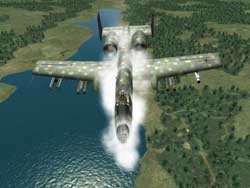 |
| It's all in the details, baby! |
- A-10
- Adjustable release interval timing on bombs
- Adjustable release quantity on bombs
- Master Arm ON / OFF
- Full weapons panels showing hardpoint status (non-interactive)
- Settable gun rate on the GAU-8
- Su-25
- Individual engine start
- Independent power system ON/OFF control (e.g., avionics, hud)
- HUD is 100 percent accurate (different than MiG29, Su27 HUDs)
- Manually adjustable altimeter
Website: Lock On: Modern Air Combat (LOMAC)
LO:MAC Su-25 Frogfoot Video
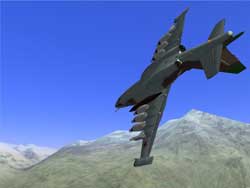 |
| Su-25 Frogfoot hops about in the Caucuses |
Cartrix has uploaded the regular Thursday LO:MAC video. Here's what you'll see:
- Su-25 “Frogfoot” 3D cockpit
- Mountain terrain of the western Caucuses
- High speed, low-altitude turbulence
- Transition from medium to low altitude terrain detail
Simulations Next To Last In Sales
It ain't easy being a fan of combat simulations when you see stats like these. According to IDSA (Interactive Digital Software Association), simulations were second to last in terms of total sales in the PC Games category. Here's an extract of the PC Games sales numbers:
On the PC game side, strategy was the top category, making up 27.4 percent of all sales, followed by children’s titles (15.9 percent), shooters (11.5 percent), family entertainment (9.6 percent), role- playing (8 percent), sports (6.3 percent), racing (4.4 percent), simulation (4.1 percent) and fighting (0.1 percent).Uggh!
Source: IDSA
BF1942 Updates
PlanetBattlefield.com has posted lots of new info today:
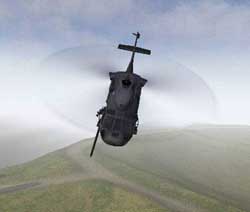 |
| New Black Hawk for Desert Combat mod |
- Poll Results (Do you plan to buy Road to Rome?)
- New Desert Combat Choppers
- Eternal Silence Models
- New TR:TGW Media!
- Big G.I. Joe Mod Update
Line of Sight: Vietnam Web Page
Infogrames has posted a new web page for Line of Sight: Vietnam
PR Info: In LINE OF SIGHT: VIETNAM you are an eagle-eyed sharpshooter in the Army’s Special Forces (better known as “The Green Berets”) at the height of America’s involvement in the Vietnam War. Surrounded by steaming jungle, you’ll stealthily position yourself and eye targets through your scope. Here, the tension is so thick a simple twig snap can mean the difference between successfully completing a mission and making the ultimate sacrifice. Dense vegetation limits visibility and conceals everything from booby traps and caves to snakes and elusive enemy soldiers. This is a world where remaining unseen is key and where speed and good judgment gets you home alive.
Game Features:
- Take out targets under the cover of a dynamic and fully detailed 3-D environment, including changing weather, booby traps, and thick vegetation
- Use over 10 different weapons, including ones dropped by enemy forces
- Tackle multiple missions in the infamous A Shau Valley, or create custom operations with the mission editor feature.
- Assume the role of a sniper alone or play cooperative multiplayer games over LAN or the Internet
- Operating System: Windows® 98/Me/2000/XP
- Processor: Pentium® III 550 MHz (Pentium® III 900 MHz or higher recommended)
- Memory: 128 MB RAM
- Hard Disk Space: 650 MB Free
- CD-ROM Drive: 8X Speed
- Video: 16 MB TNT2-class video card* (32 MB -128 MB VRAM video card recommended)
- Sound: Windows 98/Me/2000/XP-compatible sound card*
- DirectX: DirectX® version 9 (included) or higher
- Multiplayer: Internet (TCP/IP) and LAN (TCP/IP) play supported. Internet play requires Internet connection and a 56 Kbps or faster modem. DSL/Cable or other high-speed Internet connection recommended. Internet connection required for GameSpy play.
Website: Line of Sight: Vietnam
Splinter Cell for PC Goes Gold
Ubi Soft announces that development on the PC version of its stealth-based action game is finished.
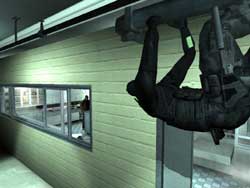 |
| This is one cool shooter! |
This is one very cool FPS, so if you haven't already played the demo, stop working now and get it!
Download: 3D Gamers
New Flight Simulator Add-ons and Repaints
FSFreeware.com have the following combat simming related downloads for the MS Flight Simulator line:
- CFS2 Curtiss P-40N v.2
G-max model, full animation, 2D-panel, 3D virtual cocpit Reworked version of my P-40N, multi-res, shiny textures, custom drop tank added, little changes, few bugs removed. Created by Krzysztof Malinowski. 3.64 mb
- A6E Intruder for X Plane 6.4
TRAM is a version of the A6E released in the late 1970's with improved laser guided weapons delivery, enhanced computers and an automatic carrier landing capability. By: Robert App. 881 kb
- FS2002 Parachute Jumper
Addon "fx" for FS2002. Parachute jumper for all planes & helicopters. By Gianni Vakirtzi
Plane Design and Repaint Web Chat
Even though this is about civilian aircraft sims, we thought it may be of interest to some of you combat sim plane designers and skinners. We learned about this from the AVSIM Site. Here's what they posted:
Ian Cockell informs us about the web chat with award winning aircraft designers and repainters Anniette and Mike Stone. Here are the details: "Have you ever wanted to understand how great Repainters and modellers work? Well here is the chance to ask them. Anniette - The Award winning Aircraft repainter will be available to answer questions about her plans and methods. Mike Stone - the Great Model designer who has given us the Boeing 757, 727 and Embraer Erj145 but also the Curtis C-46 Commando and his latest fantastic release is the Bristol Britannia. This Chat will take place at 20:00 GMT on Saturday 25 January 2003." For more information click here.More Info: Aviation Station
Air Traffic Control Simulator Sell-Off
Press Release: ATC Simulator will no longer be available for sale as a boxed version after 31 January. PC Aviator has put the calls out for your absolute last chance to get a copy of the boxed version complete with 144 page manual. ATC Simulator has been priced to clear at $19.95 (saving 60% off the normal price).
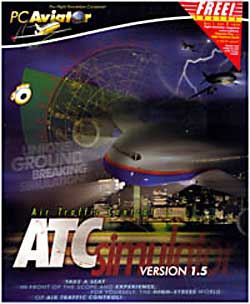 |
| ATC Simulator: Either a brilliant marketing strategy, or they really are discontinuing it. |
Only 600 boxes are left and they will be sold on a first come, first served basis. Here's you last chance to own an official boxed version of this flagship Air Traffic Control Simulator. The ordering page will be taken offline at midnight on 31 January US EST.
Order: ATC Simulator
John Carmack Speaks Out on NV30 vs R300
If you understand all that propellor-head techno stuff about video cards, then get over to Blues News! They have an article by John Carmack, legendary lead programmer at id Software, in which he discusses the relative performance differences of the NVIDIA NV30 chip versus the Radeon R300 chip.
Article: Blues News
750 MB of Secure, Rugged Storage: Zip Drive is Back
Yeah, you read right (or is that read write?...whatever!) Yes, Iomega has a new ZIP drive that holds 750 MB and unlike burning CD's you can secure the data with a password. In addition, Iomega proclaims that you can drive over one of their disks and the data will still be readable. Hmmmm? Okay, now we are interested, yes? To learn more, check out the review at THG.
Full Story: Tom's Hardware Guide
Defense and Aerospace News
Black Hawk Down! Casualties Aboard U.S. Army UH-60 Afghan CrashWASHINGTON (Reuters) - A U.S. Army UH-60 "Black Hawk" transport helicopter crashed east of Bagram Air Base in Afghanistan on Thursday and there were casualties among those aboard, the U.S. military said. A spokesman for the military's Central Command in Tampa, Florida, said the reason for the crash about 6 miles from the big base was not clear although there was no immediate indication ground fire had caused the incident. He said it was a routine training mission.
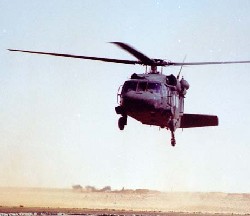 |
| UH-60 Black Hawk helicopter crashes in Afghanistan |
"A UH-60 Army helicopter is down and there are casualties," Air Force Lt. Col. Martin Compton told Reuters. He said there was no immediate information on the number of injured or extent of their injuries.
The crash of one of the Army's front-line utility helicopters came as U.S. and Afghan troops were searching more than 100 caves for rebels hiding in a mountainous region of southern Afghanistan near the border with Pakistan.
Full Story: Reuters
Combat Operation Near Spin Boldak Continues
WASHINGTON — Combat operations near Spin Boldak, Afghanistan, continued into the third day, although U.S. officials said the intensity is winding down.
U.S. Army Special Forces and Afghan militia captured an enemy gunman Jan. 27 after a shootout. The detainee said 80 or more men were holed up in the mountains to the north. Army Apache helicopters drew fire on a reconnaissance mission.
Special Forces soldiers, elements of the 82nd Airborne Division and members of the Afghan national army, about 200 to 250 troops in all, have engaged the enemy on the ground while Air Force B-1 bombers, F-16 fighters and AC-130 gunships have flown air support.
The enemy occupied tunnels and caves in an area that once was a Taliban stronghold. The town of Spin Boldak is southeast of Kandahar and on the Afghan border with Pakistan.
U.S. officials said 18 enemy combatants were killed and two men were detained. They said there still are no reports of U.S. casualties.
On Jan. 28, coalition forces searched 30 caves in the area and uncovered a number of arms caches. The caches were destroyed in place.
On Jan. 29, soldiers cleared 14 more caves and sealed up another, officials said. "They found proof of use in many of the caves -- cooking oil, cigarettes and cigarette butts," said Army Col. Roger King, a spokesman for Combined Joint Task Force 180. "They also found several more caches of weapons and pack animals."
Operations will continue in the area until all caves are searched, King said.
RAF And Royal Navy Aircrews In 14-Hour Mercy Mission
Four Royal Air Force and Royal Navy aircraft took part in a 14-hour long mission to rush a desperately sick baby to hospital in Glasgow on 21/22 January.
The week-old child was diagnosed as critically ill at St George's Hospital in Tooting, London, and needed urgent specialist care of a very advanced nature. Only four hospitals in the UK have the capacity to provide the ECMO treatment, and it was realised that it would be best provided at the Royal Hospital for Sick Children in Glasgow. The problem was how to get the child there in time, and the assistance of the Armed Forces was sought.
A Royal Navy Sea King, based at HMS Gannet, Prestwick, was scrambled at 2240 on 21 January to collect from Glasgow the specialist medical team who would be needed to keep the child alive during the transfer. The helicopter delivered them to RAF Northolt: an ambulance was waiting to rush them to St George's where they set about stabilising the baby's condition and preparing it for transfer. Meanwhile, an RAF Hercules transport was flown from RAF Lyneham to Northolt, ready to fly the baby and team back to Glasgow. However, the Hercules burst a tyre on landing, and for a short while blocked the runway. As a precaution, an RAF Sea King helicopter from Wattisham was flown to London to provide an alternative means of transport. In the event, by the time the baby was ready to be moved, the runway at Northolt had been cleared. Therefore, given that speed was so critical, one of the BAe 146 Royal and VIP jet transport aircraft operated by 32 (The Royal) Squadron was prepared at very short notice and used instead. The baby and medical team were safely delivered to Glasgow at 1220 on 22 January, almost exactly fourteen hours after the mission started.
The child, still critically ill, is now receiving treatment at the Royal Hospital for Sick Children. Our thoughts and prayers are very much with the family at this time.
The Royal Navy crew were Lieutenant Commander Mark McDermott, Lt Graham Muir, Lieutenant Dave Cole and LACMN "Skank" Walden. The RAF BAe 146 crew were Sqn Ldr Stu Rawnsley, Flt Lt Chris Toyne, and Sgt Paul Milverton - their aircraft was made ready at short notice by a servicing team under Mr Barry Kelly.
Navy Evolved Sea Sparrow Missile Test
BALTIMORE, Md. — Lockheed Martin's MK 41 Vertical Launching System (VLS) recently fired the first Evolved Sea Sparrow Missile (ESSM) from an international navy ship. The Royal Australian Navy's HMAS WARRAMUNGA, an Anzac-class frigate outfitted with MK 41 VLS, used an ESSM to successfully engage a towed, radially inbound test target.
The MK 41 VLS, an eight-cell below deck missile launching system developed by the Naval Electronics & Surveillance Systems-Marine Systems (NE&SS) unit of Lockheed Martin, was originally designed for the Navy's Aegis guided missile cruisers to provide air threat protection for naval battle groups. Over the years, the MK 41 VLS has evolved into a multi-missile, multi-mission launcher, supporting the transformation of roles and missions of world navies. No other naval missile launcher is capable of launching missiles for every naval warfare mission, including anti-air, anti-submarine, ship self-defense, land attack, and ballistic missile defense. In service aboard 173 ships, from 16 different ship classes in 11 navies, the MK 41 VLS is truly international in scope. Outfitted with the U.S. Navy qualified MK 25 Quad Pack Canister, MK 41 VLS is capable of launching four ESSMs from just one VLS cell.
According to Jim Tucker, director of launching systems at NE&SS-Marine Systems, "The ease with which the ESSM was successfully integrated in the Australian navy reflects the advantages inherent in the flexible, reliable, and open system architecture design of MK 41 VLS and shows why it is the launcher of choice for so many of the NATO Sea Sparrow navies."
Dale Bennett, vice president and general manager of NE&SS-Marine Systems, added "Nearly half of our MK 41 VLS business is international, and we are hard at work in supporting the eleven MK 41 VLS-equipped navies around the world to ensure the smooth integration of new missiles as they become available on the international market."
Lockheed Martin NE&SS provides surface ship and submarine weapon systems, antisubmarine warfare and ocean surveillance systems, missile launching systems, radar and sensor systems, ship systems integration services and other advanced systems and services to customers worldwide. NE&SS is a unit of Lockheed Martin Corporation (NYSE: LMT) headquartered in Bethesda, MD. The corporation's principal business areas are aeronautics, space, systems integration and technology services.
More Info: Lockheed Martin
Raytheon to Repair and Modify U.S. Navy Missiles, Comms, EWS
RESTON, Va. — Raytheon Company has been selected by the Naval Inventory Control Point to evaluate, test, repair, modify and deliver Raytheon-manufactured modules for the NATO Sea Sparrow Missile System, Sidewinder Missile System, AN/USC-38 Satellite Communications Terminal, SPS-49 Search Radar, SLQ-32 Electronic Warfare System, and AN/UYQ-21 and AN/UYA-4 display terminals. The one-year contract is a follow-on time and materials basic ordering agreement (BOA) valued at more than $12.5 million.
Repair and modification efforts will be performed at Raytheon Technical Services Company (RTSC) facilities in Norfolk, Va., and Chula Vista and Goleta, Calif. Raytheon's Network Centric Systems (NCS) and Integrated Defense Systems (IDS) business units manufacture the modules.
"All of Raytheon's businesses work together to ensure our customers successfully complete their missions. This is a great opportunity for us to work with our NCS and IDS counterparts to provide superior technologies and world class services to the Naval Inventory Control Point," said Bryan J. Even, a Raytheon vice president and president of Raytheon Technical Services Company. "For more than 20 years we have supported the Naval Inventory Control Point's repair and small quantity spare requirements for fielded systems, and we are pleased to continue doing so."
Website: Raytheon
F-35 Joint Strike Fighter Gets Hi Tech Service and Repair Records
ORLANDO, Fla — Lockheed Martin recently delivered Build 1 of the Test Failure Resolution Report software, the first component of an Autonomic Logistics Information System expected to significantly reduce maintenance costs for the F-35 Joint Strike Fighter.
The system, known as ALIS, serves as the information infrastructure for the F-35, transmitting information on a globally distributed network to maintenance technicians worldwide. ALIS is autonomic, meaning it can demonstrate behavior predicated on internal and external stimuli without human intervention. The F-35 aircraft's health and maintenance actions, even the location of parts, are generated through the Autonomic Logistics Information System. Currently, traditional aircraft require approximately ten hours of maintenance for every hour spent in flight. Use of the autonomic system is expected to drastically reduce this number.
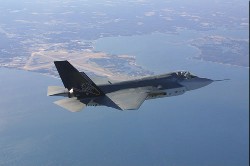 |
| Service and repair records for JSF go hi tech. |
The recently delivered Test Failure Resolution Report software application provides suppliers and vendors with a web-based application for collecting and storing test failure data, root cause analysis data, and corrective action information. This information enhances reliability of the F-35's components by identifying design deficiencies, manufacturing defects and other failures at the earliest possible opportunity.
"Autonomic logistics will redefine customer support," said John Hallal, Lockheed Martin Information Systems President. "Autonomic logistics provide affordable, responsive and flexible support solutions to enhance mission execution. The autonomic system offers faster aircraft repair with fewer people."
Lockheed Martin's Autonomic Logistics Information System also supports pilot and maintainer training by providing the infrastructure to access "on demand" electronic training on a global basis. ALIS contains a knowledge database of technical information that will reveal how any plane has been modified in the past to help determine what is needed to sustain and increase the life of military aircraft. Lockheed Martin plans to offer supply chain management, wireless and business-to-business functions using ALIS that would establish new paradigms in logistics support.
Javelin Anti-Tank Weapon For New Zealand Army
TUCSON, Ariz. — The New Zealand Army has selected the Raytheon-Lockheed Martin Javelin anti-tank weapon system to meet its medium range anti-armor weapon capability.
The number of Command Launch Units (CLU), missile quantities, along with associated support equipment, spares and training, are yet to be determined.
"Javelin's low life cycle and support cost, coupled with its unmatched lethality and operator survivability provides the New Zealand armed forces with the best anti-armor weapon system in the world," said Col. John Weinzettle, U.S. Army Close Combat Missile Systems (CCMS) project manager. "It also ensures equipment standardization with U.S. Army, Marine Corps and Special Operations Forces deployed throughout the world."
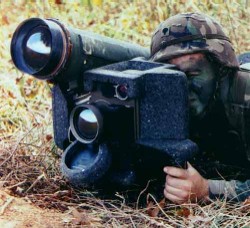 |
| Javelin: Not Just For Tanks! |
"Javelin is not only the world's most lethal medium range anti-armor system, but the weapon is ideally suited for engaging bunkers, buildings and field fortifications," said Mike Crisp, president, Javelin Joint Venture. "With its sophisticated missile seeker and tracker, the lightweight, one man- transportable Javelin anti-armor weapon system has consistently demonstrated a greater than 90 percent first-time gunner success rate.
"Javelin, with its stand-alone surveillance capability, is ideally suited for U.N. Peace Keeping and Peace Enforcement operations," said Howard Weaver, Javelin Joint Venture vice president. "Additionally, Javelin has tremendous growth potential with the missile's modular construction, CLU software enhancements and its adaptability to a wide range of platforms."
New Zealand intends to introduce the Javelin anti-armor weapon system into service in 2004, to coincide with the introduction of the Light Armored Vehicle.
The Javelin medium-range, anti-tank missile system is the world's first one man-transportable and employable fire-and-forget anti-armor missile system. Javelin is approved for international sales through the U.S. Army's Foreign Military Sales system and is available to meet national requirements for next-generation anti-armor weapon systems.
Raytheon Company, which leads the Joint Venture, provides system engineering management and support for the Javelin Joint Venture and produces the CLU, missile guidance electronic unit and system software. Work is performed primarily at Raytheon Missile Systems in Tucson, Ariz., and at other Raytheon facilities in Texas, Massachusetts and California.
Web site: Raytheon
Rescuing Two Downed Pilots Part of a Day’s Work For HS-3 Crew
ABOARD USS THEODORE ROOSEVELT, At Sea (NNS) — “Aircraft in the water. Aircraft in the water.”
The words of USS Theodore Roosevelt (CVN 71) Commanding Officer Capt. R.J. O’Hanlon spoken over the ship’s main communications intercom chilled the warmth of a Caribbean Sunday afternoon. Aircraft were returning from the day’s flights as part of its Composite Training Unit Exercise. The ship’s crew had expected to wind down the day by watching the Super Bowl via satellite.
That changed at 5:28 p.m., Atlantic Standard Time.
An F-14D Tomcat from Fighter Squadron 213 went down in the water two miles short of the flight deck, but the pilot and radar intercept officer (RIO) had ejected cleanly from the aircraft. Now, it was up to a rescue crew from Helicopter Squadron 3, based out of Jacksonville, Fla., and deployed aboard TR.
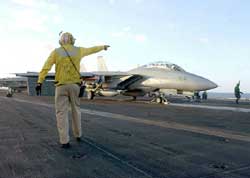 |
| At sea aboard USS Theodore Roosevelt (CVN 71) Jan. 19, 2003 -- A plane director guides an F-14 "Tomcat" assigned to the "Black Lions" of Fighter Squadron Two One Three (VF-213) into launch position on the ship's flight deck. The "Black Lions" are part of Carrier Air Wing Eight (CVW-8), embarked aboard Roosevelt, conducting training operations in the Caribbean Sea. U.S. Navy photo by Photographer's Mate 2nd James K. McNeil. (RELEASED) |
The helicopter assigned to patrol during air operations was conducting its annual Naval Aviation Training and Operating Procedures Standardization (NATOPS) certification nearby. Along with the normal crew of pilot Lt. Jason Young, Lt. John Smiley, Antisubmarine Warfare Specialist 1st Class (AC) Rafael Garcia, and search-and-rescue swimmer Antisubmarine Warfare Specialist 2nd Class (AC) Aaron Albright, Strike Fighter Squadron 201’s flight surgeon, Cmdr. Howard Eliason, happened to be along for the certification flight.
The crew heard the call that the plane might be in trouble and turned its attention away from its training to the emerging situation.
Both Young and Smiley saw the plane splash into the ocean. After coordinating with the ship, they headed to site where the pilots hit the water. It took two minutes for the helicopter to be over the pilots, ready for rescue.
Ironically, part of the NATOPS flight Sunday was a simulated search-and-rescue (SAR) while simulating mechanical failure in the helicopter.
“We practice daylight SAR every day we’re out here,” said Young. “Since we had very good visual cues (clear horizon, calm ocean), everything went very smoothly…, flawlessly.”
“This was exciting,” Albright said of this, his first rescue. “The situation was ideal, almost as easy as what they taught us in “A” school.”
Garcia, who operated the hoist to bring victims out of the water, said the hardest part of the rescue was to keep the parachutes from getting in the way of the rescue.
“My first task is to get them in and see if they are okay, get their floats off, feed info to the pilots and get the second person in,” he said. “At the same time, I’m keeping the pilots away from the chutes.
“We train for this every day so that it will be routine.”
The pilot of the downed craft was in the water five minutes before being brought aboard the helicopter, and the RIO, who was able to put out a survival raft to await rescue, was aboard in another five minutes. The helicopter was back to TR 18 minutes after the plane was reported down.
The two Tomcat crew members walked with Albright to TR’s medical department for treatment and observation.
Eliason said that he was impressed with the courage of the rescue crew. He noted Albright had “no hesitation at all” in getting in the water in spite of obstacles and hazards of being in the water with downed pilots.
“This team was so well prepared for this rescue,” said Eliason. “There was a lot of training and work that went into this rescue. Actually, it was a great honor to see the professionalism of the Sailors and Officers and how they handled everything.”
Garcia summed up the unassuming attitude of the entire aircrew and its work in rescuing the two Tomcat crew members.
“I’m glad we were able to make the difference in a couple of people who were having a bad day,” Garcia said.
Experimental Vessel Joins War on Terrorism
VIRGINA BEACH, Va. (NNS) — The crew of experimental vessel Joint Venture (HSV-X1) has spent the last year honing their skills and testing the capability of their new platform.
The buzzwords surrounding the project were always “experimental” or “testing ground,” with ship and crew operating in a training-heavy, scenario-driven environment.
America’s war on terrorism, however, changed that. The Australian-built catamaran departed Naval Amphibious Base Little Creek Jan. 25 for its first operational deployment.
The new millennium has brought many challenges and with it new approaches to old problems.
There is an emphasis on stealth, speed and quick response – how to get troops and equipment on station quickly and with little or no detection by the enemy. Defense Secretary Donald Rumsfeld referred to this school of thought as “producing a fighting force that is interoperable, agile, responsive and lethal.”
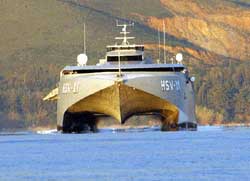 |
| Official U.S. Navy file photo of multi-service high speed vessel, Joint Venture (HSV-X1). The Australian-built catamaran departed Naval Amphibious Base Little Creek Jan. 25 on its first operational deployment in support of Operation Enduring Freedom. |
The idea of a high-speed catamaran assisting the conventional fleet was nothing short of revolutionary.
The aluminum-hulled Joint Venture boasts a fully operational flight deck and a completely computerized pilothouse, stocked entirely with commercial off-the-shelf technology.
It can carry as many as 400 troops and crew at speeds in excess of 40 knots and transport a number of different ground vehicles, small watercraft and equipment for use in any warfighting scenario. It is also one of the few Navy vessels that can get underway without any outside assistance.
With the deployment order issued, Joint Venture crew members are leaving no stone unturned in preparation for their voyage, training on everything from force protection to battle stations and even the rules of engagement.
“As an experimental vessel, we have the ability to change our operations with every mission. We want the crew to be prepared for whatever may arise,” said Master Chief Boatswain's Mate (SW/AW) Brian R. Lanear, command master chief of Joint Venture. “The key is training, training and more training. On any given day, you see two or three training sessions going on all at once.”
With the change in schedule, almost all of the original crew who brought Joint Venture from its original berth in Hobart, Tasmania, will be remaining aboard for the duration of this deployment.
"We were all supposed to rotate to different commands this summer,” said Lanear. “I don’t think any of us thought twice about being extended. We are here to support whatever operations may arise and all orders of the president of the United States.”
The makeup of the crew is a reflection of that training creed, with most of them cross-training and standing watch in both main departments (operations and engineering). The relatively small size of the crew of 50 means fewer people to run the ship. Electronics Technician 1st Class April Champeau, for example, is a technician by trade but stands watch in the engineering department as engineering officer of the watch (EOOW).
According to Champeau, having knowledge of more than one job aboard Joint Venture is a necessary tool to ensure the success of its mission.
“As a crew, we try to bring our own previous experiences to the table and incorporate that into the way we operate here. I personally never thought I would end up an EOOW, but here it’s necessary – I have to know more than one job,” said Champeau. “We pride ourselves in always thinking outside of the box here.”
Even the Army contingent pitches in a hand. Spc. Chad Worrall is part of the Army team that remains aboard when the Navy takes over operating the ship. His job, however, rings of pure naval seamanship, “turning to” as a deck seaman. That means manning mooring stations, handling cargo and the general upkeep of the ship’s spaces. He also trains side by side with his Navy counterparts as a completely integrated member of the crew.
“This has been a great opportunity to broaden my horizons and get accustomed to working in a different type of setting. The Navy is really easy to work with,” said Worrall. “I feel like I’m part of the crew in every way.”
Though Joint Venture’s mission is yet to be determined, the ship’s leadership and crew are confident that the crew are up for whatever challenges that may lie ahead.
“We’ve been experimenting with the SEALs, Marines and other groups, testing our capability to transport both personnel and equipment to various commands in different theaters,” said Lanear. “We’re becoming an asset to the fleet at a time when real world operations are springing up all over.”
"We’ve been together for a year and a half, and we work well as a team,” said Champeau. “We’re definitely ready for whatever comes our way.”
“I’m ready to get out there and do what we’ve been trained for – there’s no better time than now,” Worrall said.
BAE Systems UK Aircraft Carrier Prime Contractor
The UK Ministry of Defence has chosen BAE SYSTEMS as the Prime Contractor for the design, development, construction, systems integration and support of the UK Royal Navy's two new aircraft carriers, as announced by the Secretary of State for Defence, Geoff Hoon.
These two new flagships will be the largest warships ever ordered and ever constructed in the United Kingdom. This will also be the largest single naval procurement, production and support programme which the UK has seen in more than 50 years, with an overall government budget of £10 billion through a service life of up to 50 years.
As a result of the size and complexity of the programme, BAE SYSTEMS' approach throughout the competition has been based on collaboration with key partners in UK and US industry. The MOD has chosen the Thales team's carrier concept design, and BAE SYSTEMS welcomes Thales as a key supplier, who will bring many strengths to the programme. The approach the MOD is taking in the next stage will capitalise on the significant work done thus far in the competition by both teams.
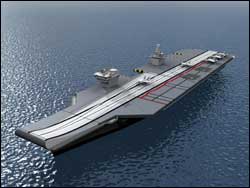 |
| BAE to build Britain's biggest ever warship. |
BAE SYSTEMS, Thales and the MOD will now engage in discussions to determine the detail for the structure of the proposed alliance. In parallel, that team will ensure that critical elements of the design work continue to move forward, so that the programme remains on schedule.
Chris Geoghegan, Chief Operating Officer, BAE SYSTEMS, said "We are delighted that BAE SYSTEMS has been chosen to be Prime Contractor for Britain's biggest ever warship contract, the next generation Carrier. We will be taking responsibility for the design and integration of the highly complex systems, as well as for the construction and support of a vital British naval system expected to be in service for the next 50 years."
"Our task now is to work with the MoD to bring together the best industrial capability Britain can offer. We look forward to working with key suppliers, including Thales, to deliver to the Royal Navy a world class sea system, vital for the protection of our national interest."
Nigel Stewart, BAE SYSTEMS Future Carrier Managing Director, said "Our collaborative approach throughout has been consistent, as a project of this size and complexity can only succeed through partnership and collaboration. We have secured robust relationships with industrial partners. We are looking forward to building on our current relationships with Thales and all the other supplier companies, continuing the excellent working relationship we have with the MOD and the Royal Navy customer on this very important programme.
Key to this team's success will be devising a successful approach to the rest of this programme, and the excellence of the major suppliers chosen.
"The MOD cited our clear understanding of the programme and our excellent relationship with our UK shipbuilding partners as key influencing factors in their decision. We are going to build on those, and the new team's expertise, to form up around the MOD and get on with building these formidable warships for the Royal Navy."
